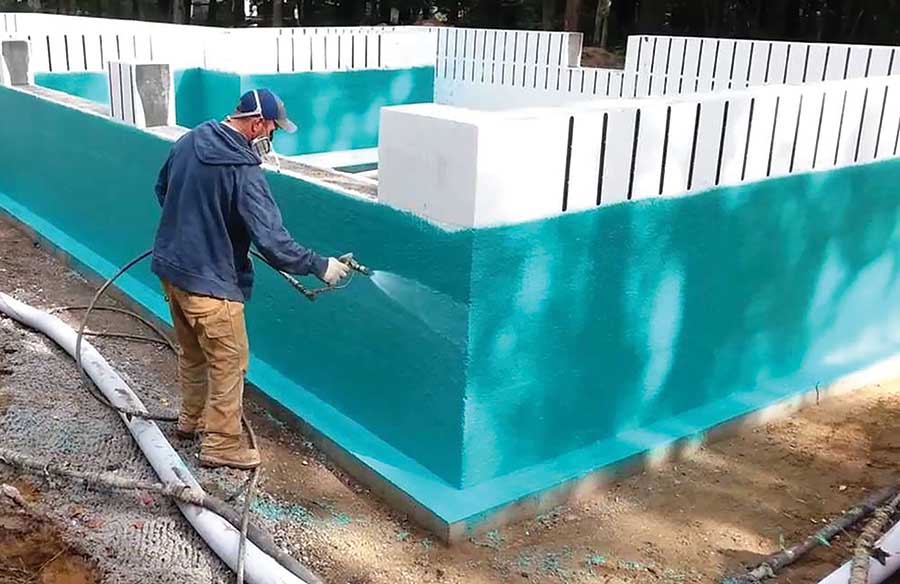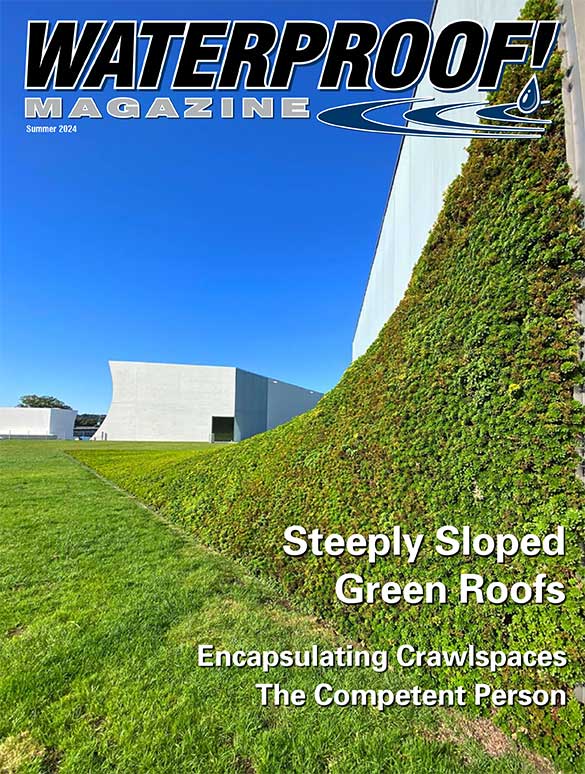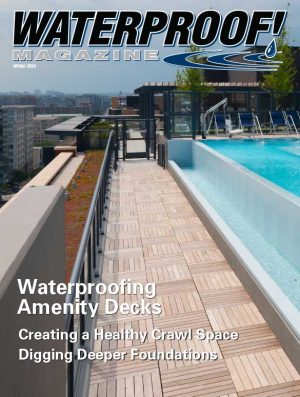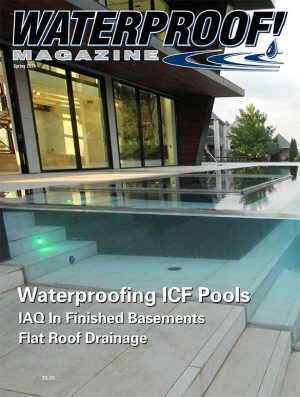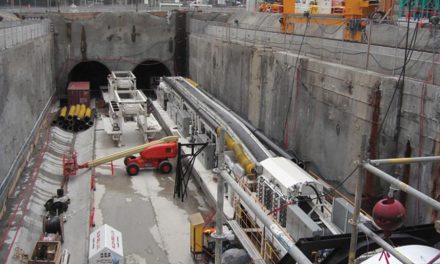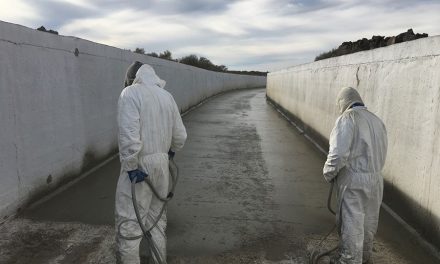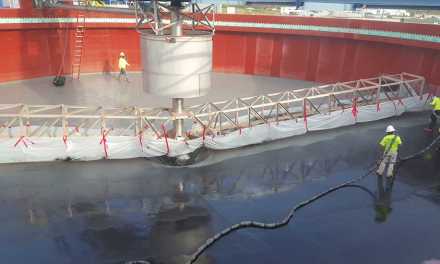By Emily Newton
Photo courtesy of Rubber Polymer Company
Managing moisture is one of the most persistent challenges in building foundations and basements. While many professionals opt for simple dampproofing in this sphere, it’s becoming increasingly common to go further. Opting for fluid-applied waterproofing instead can bring considerable value to a project.
Why Conventional Dampproofing Falls Short
Historically, full waterproofing was only necessary for foundations in particularly wet regions. However, climate shifts mean more projects fall under that umbrella than they used to. Heavy rains are becoming more common across the U.S., with nine of the top 10 years for extreme precipitation events happening after 1996, according to the EPA.
How people use underground spaces is also changing. A little moisture may not be a pressing concern if a basement only houses the laundry and utilities. As housing difficulties continue, though, basement-level bedrooms, offices and rec rooms are becoming more common. Consequently, preventing seepage in the foundation is a more serious issue.
Conventional dampproofing cannot meet these rising needs. Asphalt coatings and similar methods perform well under normal conditions, but they fail to cover cracks that may arise in foundations. This is particularly pressing in cold regions, as freezing water chips away concrete as it expands.
Dampproofing also struggles to keep out water under pressure. Standing water can exert considerable force on a foundation, leading to leakage through any concrete imperfections or creating cracks. Given these concerns, liquid-applied membranes are an increasingly advantageous waterproofing solution.
Benefits of Fluid-Applied Waterproofing
Fluid-applied waterproofing excels in all these areas where simple dampproofing falls short. Most notably, international standards require these solutions to bridge cracks at low temperatures. Consequently, as cracks form from age, pressure or ice, the membrane remains intact, preventing seepage despite these flaws.
Similarly, liquid waterproofing is seamless. Applying it as a spray lets teams cover the entire foundation in a cohesive layer instead of joining separate components. This cohesion means there are no structural weak points in the membrane, making it more resilient in the long term. It also makes this layer easier to apply without errors. Compared to other full waterproofing methods, liquid-applied membranes are also relatively affordable. That’s partly due to the low cost of the materials themselves and partly because the application is fast and simple. As a result, opting for this method entails lower labor expenses.
Making the Most of Membranes
As with any strategy, fluid-applied waterproofing’s real-world effectiveness depends on how well employees can apply it. Here are some steps to consider to use these membranes to their full potential.
Choose the Right Membrane Type
First, it’s important to recognize that not all liquid-applied membranes are the same. Many manufacturers sell these materials in varying grades, with higher-grade options offering greater water resistance. Teams should consider their project’s region and wetness to determine the optimal balance between costs and hydrostatic head.
Now that sustainability is one of the biggest trends in construction, firms should also consider their membrane’s material makeup. Some liquid waterproofing has higher concentrations of volatile organic compounds or other materials that pose environmental risks. Greener projects or those in areas with higher environmental regulations should opt for more eco-friendly alternatives.
Curing times, adhesion, tensile strength and abrasion resistance can also vary widely between fluid-applied membranes. While higher ratings in each category are always ideal, some projects may need to sacrifice one category for another, depending on their unique needs.
Apply Carefully
Next, teams should take care when applying their membrane. For all of liquid-applied waterproofing’s benefits, it runs the risk of uneven application. Rushing through a job or failing to account for surface imperfections in the concrete will result in varying thicknesses, creating weak points.
Thorough employee training will help prevent these situations. Applying the membrane in multiple layers is often beneficial, too, as it reinforces any thin points in the initial spray.
Workers should also wait to apply waterproofing membranes until the concrete beneath it has cured fully. That typically takes 28 days, so it’s important to plan projects accordingly to allow enough time after laying foundations to waterproof them. Similarly, workers should wait for membranes to dry and cure before applying additional layers.
Consider Hybrid Approaches
As beneficial as fluid-applied waterproofing is, the most effective approach is often to combine it with other methods. Applying a liquid membrane before placing dimple mats, for example, provides an additional layer of protection if water somehow gets through the first.
Hybrid approaches can combine any number of waterproofing and dampproofing methods to fit a project’s unique needs. The most important thing is to ensure one layer’s strengths compensate for the other’s weak points.
Of course, using multiple waterproofing methods is expensive and time-consuming. Consequently, it may only be necessary for projects with higher flood or moisture risks.
The Protection Foundations Need
Waterproofing needs are changing. Construction projects must adapt to this shift, especially in structures as crucial as the foundation. In many instances, that means using liquid-applied membranes to ensure long-term resilience while balancing costs. As long as teams can apply these layers carefully, they can see significant improvements in their project quality.
Emily Newton
Emily Newton is the Editor-in-Chief of Revolutionized, an online magazine covering the technologies advancing the industrial sector.
Summer 2024 Back Issue
$4.95 – $5.95
Properly Encapsulating a Crawlspace
The Competent Person
Pushing the Envelope: Steeply Sloped Green Roofs
Transforming Foundations with Fluid-Applied Membranes for Superior Protection
Description
Description
Properly Encapsulating a Crawlspace
By Vanessa Salvia
For many homeowners, the crawlspace is an out-of-sight, out-of-mind area. However, leaving this space unchecked can lead to moisture problems, poor indoor air quality, and wasted energy.
The Competent Person
By Gregory Fahrenbruch
When dealing with asbestos, OSHA has requirements for what is considered “a competent person.” Having awareness training is good, but be aware of whether the person giving you advice is actually “competent.”
Pushing the Envelope: Steeply Sloped Green Roofs
By Richard Hayden, GRP, ASLA Emeritus
Architects continue to push the boundaries of design and construction, and the roof is no exception. The roof was once the repository of HVAC equipment and other building utility equipment. No more.
Transforming Foundations with Fluid-Applied Membranes for Superior Protection
By Emily Newton
Managing moisture is one of the most persistent challenges in building foundations and basements. While many professionals opt for simple dampproofing in this sphere, it’s becoming increasingly common to go further. Opting for fluid-applied waterproofing instead can bring considerable value to a project.
Additional Info
Additional information
| Weight | N/A |
|---|---|
| Magazine Format | Digital Download Magazine, Print Mailed Magazine |

